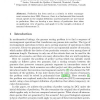RECOMB
2010
Springer
14 years 1 months ago
2010
Springer
Chaining fragments is a crucial step in genome alignment. Existing chaining algorithms compute a maximum weighted chain with no overlaps allowed between adjacent fragments. In prac...
RECOMB
2010
Springer
14 years 1 months ago
2010
Springer
Background: Genomic rearrangements have been studied since the beginnings of modern genetics and models for such rearrangements have been the subject of many papers over the last ...
RECOMB
2010
Springer
14 years 1 months ago
2010
Springer
Abstract. Perfection has been used as a criteria to select rearrangement scenarios since 2004. However, there is a fundamental bias towards extant species in the original definitio...
RECOMB
2010
Springer
14 years 1 months ago
2010
Springer
In comparative genomics studies, finding a minimum length sequences of reversals, so called sorting by reversals, has been the topic of a huge literature. Since there are many mini...
RECOMB
2010
Springer
14 years 1 months ago
2010
Springer
(Motivation) Tree reconciliation is an approach that explains the discrepancies between two evolutionary trees by a number of events such as speciations, duplications, transfers an...
RECOMB
2010
Springer
14 years 1 months ago
2010
Springer
An important question in genome evolution is whether there exist fragile regions (rearrangement hotspots) where chromosomal rearrangements are happening over and over again. Althou...
RECOMB
2010
Springer
14 years 1 months ago
2010
Springer
RECOMB
2010
Springer
14 years 1 months ago
2010
Springer
RECOMB
2010
Springer
14 years 1 months ago
2010
Springer
In comparative genomics, various combinatorial models can be used to specify gene clusters — groups of genes that are co-located in a set of genomes. Several approaches have been...
RECOMB
2010
Springer
14 years 1 months ago
2010
Springer
Motivated by the trend of genome sequencing without completing the sequence of the whole genomes, Mu˜noz et al. recently studied the problem of filling an incomplete multichromos...




